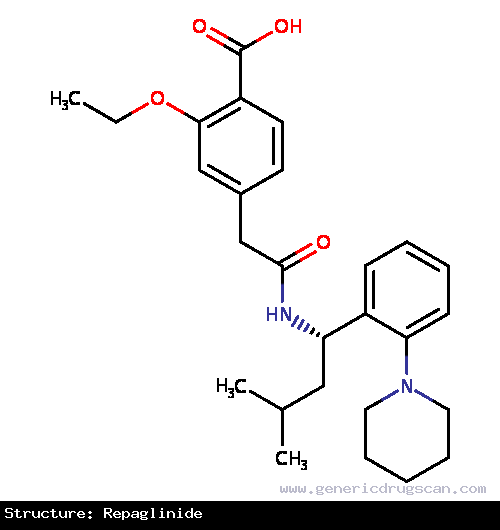Repaglinide Drug: Indication, Dosage, Precaution, Side Effect , Storage, Category Type and corresponding Brands - www.genericdrugscan.com
Repaglinide
Drug Status in USA : ApprovedDrug Status in Canada : Approved
pronunciation
pronounced as (re pag' lin ide)
Why is this medication prescribed?
Repaglinide is used to treat type 2 diabetes (condition in which the body does not use insulin normally and, therefore, cannot control the amount of sugar in the blood). Repaglinide helps your body regulate the amount of glucose (sugar) in your blood. It decreases the amount of glucose by stimulating the pancreas to release insulin.
Over time, people who have diabetes and high blood sugar can develop serious or life-threatening complications, including heart disease, stroke, kidney problems, nerve damage, and eye problems.Taking medication(s), making lifestyle changes (e.g., diet, exercise, quitting smoking), and regularly checking your blood sugar may help to manage your diabetes and improve your health. This therapy may also decrease your chances of having a heart attack, stroke, or other diabetes-related complications such as kidney failure, nerve damage (numb, cold legs or feet; decreased sexual ability in men and women), eye problems, including changes or loss of vision, or gum disease. Your doctor and other healthcare providers will talk to you about the best way to manage your diabetes.
This medication is sometimes prescribed for other uses; ask your doctor or pharmacist for more information.
How should this medicine be used?
Repaglinide comes as a tablet to take by mouth. The tablets are taken before meals, any time from 30 minutes before a meal to just before the meal. If you skip a meal, you need to skip the dose of repaglinide. If you add an extra meal, you need to take an extra dose of repaglinide. Your doctor may gradually increase your dose, depending on your response to repaglinide. Follow the directions on your prescription label carefully, and ask your doctor or pharmacist to explain any part you do not understand. Take repaglinide exactly as directed. Do not take more or less of it or take it more often than directed by the package label or prescribed by your doctor.
Continue to take repaglinide even if you feel well. Do not stop taking repaglinide without talking to your doctor.
What are the precautions to be followed?
Before taking repaglinide,- tell your doctor and pharmacist if you are allergic to repaglinide or any other drugs.
- tell your doctor if you are taking gemfibrozil (Lopid). Your doctor will probably tell you not to take repaglinide if you are taking this medication.
- tell your doctor and pharmacist what prescription and nonprescription medications, vitamins, nutritional supplements, and herbal products you are taking or plan to take. Be sure to mention any of the following: acetophenazine (Tindal), aspirin, blood pressure medicines, carbamazepine (Tegretol), chloramphenicol (Chloromycetin), chlorpromazine (Thorazine), corticosteroids, diuretics ('water pills'), drugs for arthritis, erythromycin, troglitazone (Rezulin), estrogens, fluphenazine (Prolixin), isoniazid (Rifamate), ketoconazole (Nizoral), mesoridazine (Serentil), oral contraceptives, perphenazine (Trilafon), phenelzine (Nardil), phenobarbital (Luminal), phenytoin (Dilantin), probenecid (Benemid), prochlorperazine (Compazine), promazine (Sparine), promethazine (Phenergan), rifampin (Rifadin, Rimactane), thioridazine (Mellaril), tranylcypromine (Parnate), trifluoperazine (Stelazine), triflupromazine (Vesprin), trimeprazine (Temaril), vitamins, or warfarin (Coumadin). Your doctor may need to change the doses of your medications or monitor you carefully for side effects.
- tell your doctor if you have or have ever had liver or kidney disease or if you have been told you have type I diabetes mellitus.
- tell your doctor if you are pregnant, plan to become pregnant, or are breast-feeding. If you become pregnant while taking repaglinide, call your doctor.
- if you are having surgery, including dental surgery, tell the doctor or dentist that you are taking repaglinide.
What are possible side effects of this medication ?
This medication may cause changes in your blood sugar. You should know the symptoms of low and high blood sugar and what to do if you have these symptoms.You may experience hypoglycemia (low blood sugar) while you are taking this medication. Your doctor will tell you what you should do if you develop hypoglycemia. He or she may tell you to check your blood sugar, eat or drink a food or beverage that contains sugar, such as hard candy or fruit juice, or get medical care. Follow these directions carefully if you have any of the following symptoms of hypoglycemia:
- shakiness
- dizziness or lightheadedness
- sweating
- nervousness or irritability
- sudden changes in behavior or mood
- headache
- numbness or tingling around the mouth
- weakness
- pale skin
- hunger
- clumsy or jerky movements
- confusion
- seizures
- loss of consciousness
- extreme thirst
- frequent urination
- extreme hunger
- weakness
- blurred vision
- dry mouth
- upset stomach and vomiting
- shortness of breath
- breath that smells fruity
- decreased consciousness
- headache
- nasal congestion
- joint aches
- back pain
- constipation
- diarrhea
How to store the medication and dispose it of after its use later?
Keep this medication in the container it came in, tightly closed and out of reach of children. Store it at room temperature and away from excess heat and moisture (not in the bathroom).
Unneeded medications should be disposed of in special ways to ensure that pets, children, and other people cannot consume them. However, you should not flush this medication down the toilet. Instead, the best way to dispose of your medication is through a medicine take-back program.
Drug Category/Class
- Hypoglycemic Agents
- Antidiabetic Agents
- Meglitinides
- Blood Glucose Lowering Drugs, Excl. Insulins
- Drugs Used in Diabetes
- Cytochrome P-450 CYP2C8 Inhibitors
- Cytochrome P-450 CYP2C8 Inducers
- Alimentary Tract and Metabolism
- CYP3A4 Inhibitors
- Combinations of oral blood glucose lowering drugs
- Other blood glucose lowering drugs, excl. insulins
| Prescribed | As an adjunct to diet and exercise to improve glycemic control in adults with type 2 diabetes mellitus. |
| Weight : | 452.5857 |
| Structure | Repaglinide |
 | |
| Formula | C27H36N2O4 |
Repaglinide has 29 Brands listed
Search Generic Drugs alphabetically
